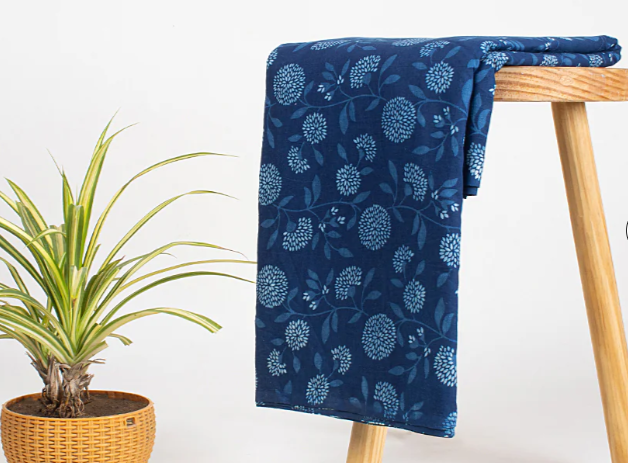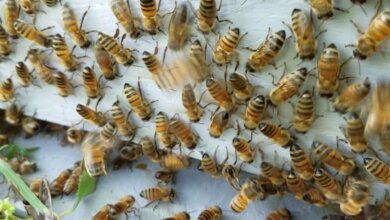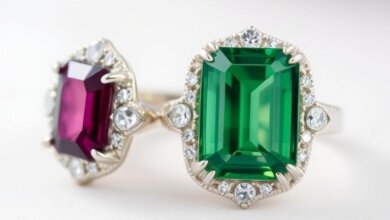Hand Block Printed Fabric: A Timeless Craft of Art and Heritage
What is Hand Block Printed Fabric?

Hand block printed fabric refers to textiles decorated using a traditional method of woodblock printing, where intricate patterns are carved into wooden blocks, dipped in natural dyes, and stamped onto fabric by hand. This centuries-old practice, rooted in India, is not just a printing technique but a living tradition of storytelling, craftsmanship, and cultural heritage.
The Rich History Behind Hand Block Printing
The origins of hand block printing date back over 4,000 years, with India recognised as one of the oldest centres of this craft. The regions of Rajasthan, particularly Bagru, Sanganer, and Barmer, and Gujarat are renowned for preserving this traditional art. These communities have passed down the skill across generations, using age-old tools and methods that remain largely unchanged.
Each region has developed its own distinctive patterns, color palettes, and motifs, often reflecting local flora, fauna, and folklore. The influence of Mughal designs, Persian aesthetics, and tribal inspirations has added richness and variety to block printed fabrics.
The Craftsmanship Behind Every Yard
Creating hand block printed fabric involves meticulous craftsmanship, requiring precision, patience, and an expert understanding of materials. The process includes:
1. Carving the Blocks
Skilled artisans carve intricate designs into teakwood blocks by hand, sometimes using a separate block for each color in a pattern. These blocks, known as ‘bunta’, can take days or even weeks to perfect depending on complexity.
2. Preparing the Fabric
The fabric, usually cotton, silk, or linen, is first washed and treated with natural mordants to ensure dye absorption. It is then stretched over long tables to create a smooth surface for printing.
3. Mixing Natural Dyes
Traditional block printing employs eco-friendly natural dyes derived from plants, minerals, and spices, such as indigo, madder root, pomegranate rind, and turmeric. The use of these dyes not only reflects sustainability but also gives fabrics a rich, earthy tone and a unique depth that synthetic dyes cannot replicate.
4. Hand Printing Process
Artisans meticulously dip each block into dye trays and press them onto the fabric, aligning them with precision to ensure continuity of design. A single misalignment can ruin the entire piece, showcasing the skill and care involved in the process.
5. Post-Printing Treatments
Once printed, the fabrics are dried in natural sunlight, washed, and sometimes boiled with natural fixatives to set the dye and enhance vibrancy. The final product is then ready for use in garments, home décor, or upholstery.
Types of Hand Block Printed Fabrics
Bagru Print
Originating from Rajasthan, Bagru prints are known for vegetable dyes and earthy motifs, often featuring floral, geometric, and nature-inspired patterns on light-colored fabrics. The mud-resist printing technique (dabu) is also commonly used here.
Sanganeri Print
Also from Rajasthan, Sanganeri prints are celebrated for their fine detailing and use of vibrant colors like red, blue, and yellow. Designs often include butis, paisleys, and mughal-inspired motifs on white or off-white bases.
Ajrakh Print
With roots in Kutch (Gujarat) and Sindh (Pakistan), Ajrakh printing involves a complex, multi-step resist-dyeing technique using natural indigo and madder, resulting in deep reds and blues with symmetrical, intricate designs.
Kalamkari Print
Though technically freehand or pen-drawn, Kalamkari also incorporates block printing in many modern iterations. These fabrics often depict mythological scenes, temples, and epic narratives, making them unique in storytelling.
Why Choose Hand Block Printed Fabric?
1. Eco-Friendly and Sustainable
Unlike mass-produced textiles, hand block printed fabric uses natural dyes, organic materials, and low-energy processes, making it a preferred choice for environmentally conscious consumers.
2. Unique and Handmade
No two pieces are exactly alike. Each yard of fabric reflects the artisan’s hand, making every piece one-of-a-kind with slight variations that add character and charm.
3. Ethically Made
By choosing block printed textiles, consumers support local artisans, fair trade practices, and the preservation of traditional crafts in rural communities across India.
4. Versatile Applications
Hand block printed fabrics are highly versatile and used in a variety of forms:
-
Clothing: Sarees, kurtas, dresses, scarves
-
Home décor: Cushion covers, bedspreads, curtains
-
Accessories: Tote bags, pouches, table runners
Modern Adaptations in Contemporary Fashion
Designers and fashion houses worldwide are embracing hand block prints for their authenticity, sustainability, and timeless appeal. From high-end runway collections to boho-chic everyday wear, these fabrics are redefining slow fashion.
Fusion of traditional motifs with modern cuts, layered prints, and global silhouettes has given block printed garments a fresh identity. Moreover, the resurgence of minimalism, natural fabrics, and handmade textures in lifestyle trends continues to elevate the demand for hand block printed textiles.
Caring for Hand Block Printed Fabric
To preserve the beauty of block printed fabrics:
-
Hand wash separately in cold water with mild detergent
-
Avoid harsh sunlight while drying to maintain dye vibrancy
-
Do not wring or twist the fabric
-
Iron on reverse side at low temperature
With proper care, these fabrics age gracefully, gaining a soft patina over time.
Where to Buy Authentic Hand Block Printed Fabrics
Authentic hand block printed fabrics are available through:
-
Local artisan cooperatives and craft fairs in India
-
Online platforms specializing in handmade or sustainable textiles
-
Boutique fashion labels that collaborate directly with artisans
-
Government emporiums and handloom centers
Always ensure you’re buying from ethical sources that provide fair wages and working conditions to artisans.
Read more blogs The Global Newz.
Conclusion
Hand block printed fabric is more than just a textile—it’s a celebration of human skill, cultural legacy, and sustainable artistry. Its growing popularity is a testament to the global shift towards ethical fashion and appreciation for slow, handcrafted processes. By choosing these fabrics, we honor centuries of tradition while embracing a more conscious and meaningful way of living.







